| Image | Scientific name | Distribution |
|---|
 | Drosera acaulis L.f. | South Africa (Cape Province) |
 | Drosera admirabilis Debbert | South Africa |
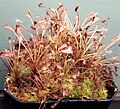 | Drosera affinis Welw. ex Oliv. | South Africa |
| Drosera afra E.Phillips | Cape Provinces of South Africa |
 | Drosera aliciae Raym.-Hamet | Cape Provinces of South Africa |
| Drosera amazonica Rivadavia, A.Fleischm. & Vicent. | Amazonas and Roraima State, Brazil |
 | Drosera anglica Huds. | Circumboreal (Eurasia and North America), extending as far south as Japan, southern Europe, and Kauai |
| Drosera arachnoides Rakotoar. & A.Fleischm. | Madagascar |
| Drosera arenicola Steyerm. | Venezuela and Brazil |
| Drosera ascendens A.St.-Hil. | Brazil (Minas Gerais) |
| Drosera atrostyla Debbert | Cape Provinces of South Africa |
| Drosera bequaertii Taton | Congo and Angola |
| Drosera biflora Willd. ex Schult. | Venezuela to Brazil, |
 | Drosera brevifolia Pursh | east Texas to Florida and north to Virginia |
| Drosera burkeana Planch. | Congo and Uganda to South Africa, Madagascar. |
| Drosera camporupestris Rivadavia | Brazil (Minas Gerais) |
 | Drosera capensis L. | Cape in South Africa. |
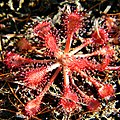 | Drosera capillaris Poir. | southern United States, the Greater Antilles, wastern and southern Mexico, Central America, and northern South America |
| Drosera cayennensis Sagot ex Diels | Costa Rica to S. Tropical America. |
| Drosera cendeensis Tamayo & Croizat | Venezuela |
| Drosera chrysolepis Taub. | Brazil (Bahia to Minas Gerais) |
| Drosera cistiflora L. | Cape Provinces of South Africa |
 | Drosera collinsiae N.E.Br. | South Africa. |
 | Drosera communis A.St.-Hil. | Brazil |
 | Drosera cuneifolia L.f. | Cape in South Africa |
| Drosera curvipes Planch. | Northern Provinces, Swaziland |
 | Drosera dielsiana Exell & J.R.Laundon | South Africa (KwaZulu-Natal, the Free State, the Northern Provinces), Eswatini (Swaziland), Mozambique, Malawi, and Zimbabwe. |
| Drosera elongata Exell & J.R.Laundon | Zambia |
| Drosera ericgreenii A.Fleischm., R.P.Gibson & Rivadavia | Western Cape of South Africa |
| Drosera esmeraldae (Steyerm.) Maguire & Wurdack | Venezuela |
| Drosera esterhuyseniae (T.M.Salter) Debbert | Western Cape of South Africa |
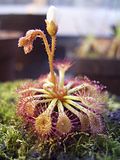 | Drosera felix Steyerm. & L.B.Sm. | Venezuela |
 | Drosera filiformis Raf. | Canada and the United States |
| Drosera glabripes (Harv. ex Planch.) Stein | Cape in South Africa |
| Drosera graminifolia A.St.-Hil. | Minas Gerais in Brazil |
| Drosera grantsaui Rivadavia | Brazil to Paraguay |
 | Drosera graomogolensis T.R.S.Silva | Minas Gerais in Brazil |
 | Drosera hamiltonii C.R.P.Andrews | Western Australia. |
| Drosera hirtella A.St.-Hil. | Brazil |
 | Drosera hilaris Cham. & Schltdl. | South Africa |
| Drosera hirticalyx Duno de Stefano & Culham | Venezuela |
| Drosera humbertii Exell & J.R.Laundon | Madagascar |
| Drosera insolita Taton | Democratic Republic of the Congo |
 | Drosera intermedia Hayne | Europe, southeastern Canada, the eastern half of the United States, Cuba, Hispaniola, and northern South America |
 | Drosera kaieteurensis Brumm.-Ding. | Guyana |
| Drosera katangensis Taton | Democratic Republic of Congo. |
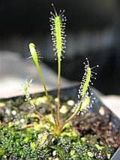 | Drosera linearis Goldie | Canada and the United States |
 | Drosera madagascariensis DC. | Africa (Guinea, Nigeria, Cameroon, Congo, Angola, Zambesi, Tanganyika) as far south as South Africa and east to the island of Madagascar. |
 | Drosera montana A.St.-Hil. | Brazil |
 | Drosera natalensis Diels | South Africa |
 | Drosera neocaledonica Raym.-Hamet | New Caledonia |
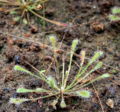 | Drosera nidiformis Debbert | KwaZulu-Natal in South Africa |
| Drosera oblanceolata Y.Z.Ruan | southern China |
 | Drosera pauciflora Banks ex DC. | Cape Provinces of South Africa. |
| Drosera peruensis T.R.S.Silva & M.D.Correa | Peru |
| Drosera pilosa Exell & J.R.Laundon | Zambia |
| Drosera quartzicola Rivadavia & Gonella | Brazil (Minas Gerais) |
| Drosera ramentacea Burch. ex DC. | Western Cape of South Africa. |
 | Drosera roraimae (Klotzsch ex Diels) Maguire & J.R.Laundon | northern North America, Korea and Japan |
 | Drosera rotundifolia L. | Europe and northern North America. |
| Drosera rubrifolia Debbert | Cape Provinces of South Africa. |
| Drosera schwackei (Diels) Rivadavia | Brazil (Minas Gerais) |
 | Drosera slackii Cheek | Cape Provinces of South Africa. |
| Drosera solaris A.Fleischm., Wistuba & S.McPherson | Guyana. |
 | Drosera spatulata Labill. | Southeast Asia, southern China and Japan, Micronesia, Papua New Guinea, eastern Australia, Tasmania and New Zealand. |
| Drosera spiralis A.St.-Hil. | Brazil (Minas Gerais) |
 | Drosera tentaculata (Komiya & Shibata) T.Nakamura & Ueda | Japan. |
 | Drosera tokaiensis Rivadavia | Brazil |
 | Drosera tomentosa A.St.-Hil. | Brazil |
 | Drosera trinervia Spreng. | Cape Provinces of South Africa |
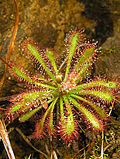 | Drosera ultramafica A.Fleischm., A.S.Rob. & S.McPherson | Malesia. |
 | Drosera uniflora Willd. | Chile |
 | Drosera venusta P.Debbert | Cape Provinces of South Africa |
| Drosera villosa A.St.-Hil. | Brazil (E. Minas Gerais) |
| Drosera viridis Rivadavia | Brazil ( Paraná and São Paulo and central Santa Catarina) |
| Drosera yutajensis Duno de Stefano & Culham | Venezuela |
| Drosera zeyheri T.M.Salter | Cape Provinces of South Africa |
|




































